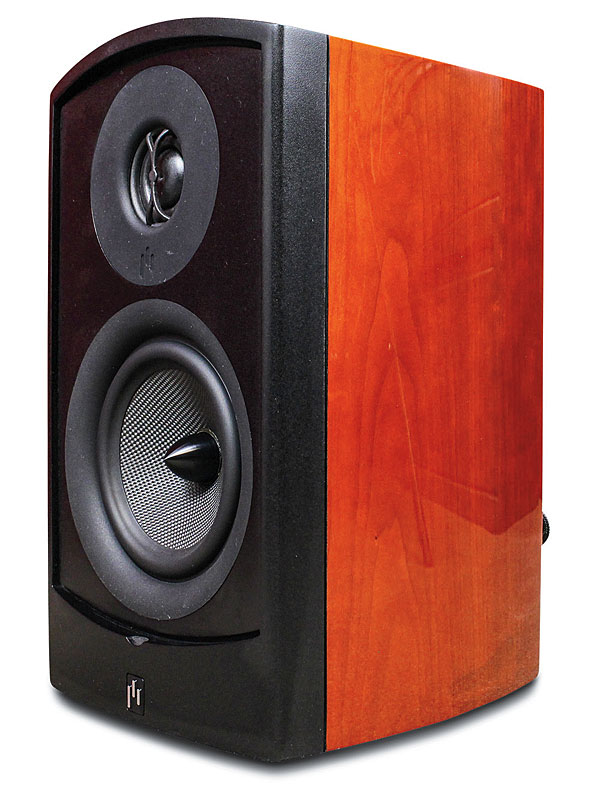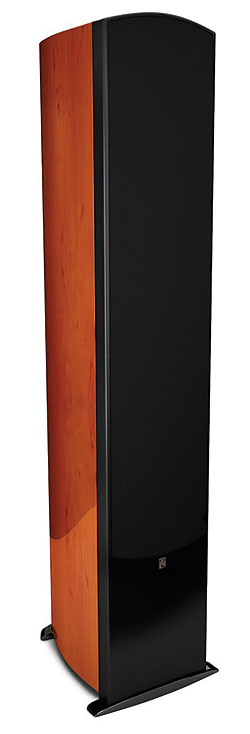I really wish more speaker manufacturers would make large LCR versions of their speakers. I guess in a way the center channel could be considered one, and I have been noticing this strange (to me) trend of high-end speaker companies making monitor style speakers that are horizontally situated instead of vertically. I wonder how much of a difference there'd be in populating your home theater with "center channel" speakers instead of vertical LCRs.
Aperion Audio Verus II Grand Speaker System Review

AT A GLANCE
Plus
Tight, detailed bass
Excellent tonal balance
Spacious, cohesive
soundstage
Minus
Sub has limitations in very large rooms
Narrow tower can be unstable on carpet
THE VERDICT
With modest but significant improvements to their flagship speaker line, Aperion Audio has again hit the jackpot in offering the sort of value that’s rare in today’s increasingly pricey audio marketplace.
Six years ago, I reviewed the first version of Aperion Audio’s then new Verus Grand speaker line. While this was a considerable step up from the internet-direct manufacturer’s previous, well-regarded budget-priced models, it still offered incredible value. As I concluded at the time: “If [the Verus Grand] impresses you as much as [it] impressed me, you’ll ultimately be a winner.”
Now this Portland, Oregon–based company has a fresh lineup, the Verus II Grand. Like Aperion’s other speakers, they’re designed in the U.S. but built in China. Fifteen years ago, such an arrangement was uncommon, but today most of the world’s relatively affordable audio products (and some not-soaffordable ones) are manufactured in eastern Asia.
To allay customer concerns about buying a speaker system for which no dealer audition is possible, Aperion provides a 60-day moneyback guarantee. This includes shipping both ways in the U.S. (Alaska and Hawaii excepted). Aperion also provides a 10-year transferrable warranty (three years on subwoofer amplifiers), with reasonable limitations.
Our review system included the Verus II Grand Tower, the Verus II Grand Center Channel, and the Verus II Grand Bookshelf (used here as surrounds). Aperion also sent us the very compact Bravus II 12D subwoofer.
An Aperion system arrives like a Christmas delivery: Everything is carefully and lovingly wrapped. If you open the shipping box of each tower the correct way, you’ll find the feet/outriggers and mounting screws snuggled into the styrofoam on top. Move aside the velour and plastic bags (which protect the tower), fasten the feet to the speaker, and then turn the box over and slide it up, up, and away, leaving the speaker upright with only the velour and plastic bags left to remove. The perforated-metal grille is already installed, so there’s no risk of putting a finger through a speaker cone while you free the speaker from its box and packing material.

The other speakers are similarly packed, though their extraction is even simpler. It took me less than an hour, working alone, to unpack the six speakers in the system. But Aperion recommends that most customers find at least one helper. (After all, most customers—unlike reviewers—don’t unpack, set up, and then repack several products every month.)
Design
The Verus II Grand models are available in either Gloss Cherry or Gloss Black, as is the Bravus II 12D sub. Our Gloss Cherry samples were even better looking than the Cherry that I recall on the original Verus Grand speakers. Those speakers had also punched above their price in the looks department. But our Verus IIs appeared to have a more distinctive grain pattern beneath their glossy layer, giving the new models a more upscale look.
Aperion isn’t overly…um…grand in describing how the Verus IIs differ from the originals. A new, patented tweeter in all of the models uses a pinned-center design (as did the originals), a variation on the basic principle behind the bullet-nosed tweeter used by a number of other manufacturers. This is said to eliminate phase cancellations (and thus uneven response) that can occur when the unsupported center of a conventional dome tweeter operates out of phase with its periphery. Aperion calls this tweeter an Axially Stabilized Radiator. There’s also an updated crossover. The claimed sonic improvements are a clearer top end (with a wider listening sweet spot), a more articulate midrange, and higher power handling.
 Visible differences in the Verus IIs from the originals were hard to spot. The cabinets are aesthetically unchanged; they’re still gently curved on the sides (and, in the tower and bookshelf models, on top). Each tower is tall, slender, and sturdy, and at 65 pounds, it’s not overly heavy. The narrowness of the tower cabinet, supported by feet/outriggers that don’t extend particularly far to the sides, does raise a small concern about the speaker’s side-to-side stability on a thick carpet—particularly if there are small children, large dogs, or clumsy friends in the house. Spikes are included if you have a suitable floor for them, though I wasn’t able to use them.
Visible differences in the Verus IIs from the originals were hard to spot. The cabinets are aesthetically unchanged; they’re still gently curved on the sides (and, in the tower and bookshelf models, on top). Each tower is tall, slender, and sturdy, and at 65 pounds, it’s not overly heavy. The narrowness of the tower cabinet, supported by feet/outriggers that don’t extend particularly far to the sides, does raise a small concern about the speaker’s side-to-side stability on a thick carpet—particularly if there are small children, large dogs, or clumsy friends in the house. Spikes are included if you have a suitable floor for them, though I wasn’t able to use them.
The cloth-covered, perforated-metal grilles are a snug fit, but they can be removed with relative ease if desired. Beneath them is the same complement of drivers as before. Each tower employs two 6-inch woofers in a vented chamber and two 5-inch midranges, the latter above and below the 1-inch soft dome tweeter. All of the cones are woven Kevlar, and the midranges have aluminum phase plugs. These bullet-shaped devices can help smooth a driver’s frequency response and remove heat from the metal parts near the current-carrying voice coil.
The center speaker remains a desirable three-way design, with two 6-inch woofers flanking a vertically arrayed 1-inch tweeter and 4-inch midrange. Each bookshelf model employs a single 5-inch woofer and a 1-inch tweeter. The tower and the bookshelf each have dual pairs of high-quality terminals that are suitable for biamping or biwiring (I used single wiring). The center has only a single pair.
The Bravus II 12D subwoofer’s 650-watt (rated) amplifier drives a single down-firing 12-inch high-excursion aluminum cone driver supported by a pair of 12-inch passive radiators (one on either side). You must use either the included spikes or feet to provide clearance from the floor. There are Left/Right speaker-level inputs plus three line-level inputs: Left, Right, and LFE. I opted for the LFE input, which defeats the sub’s internal low-pass crossover when used with an A/V receiver or preamp/processor. The use of the label “LFE” for such an input is common but misleading. Typically, as in my setup, the bass frequencies from all of the main channels below the AVR- or pre/pro-selected crossover frequency and the LFE bass in the source’s LFE (0.1) channel are combined and sent to this input.
The controls on the Bravus II 12D include Level, Crossover, 2-position Phase (0 and 180 degrees), and Power. You can switch the Power control to On, Off, or Auto. (The last option energizes the sub only when it detects a signal.) You’ll also find a USB power port (presumably for third-party wireless receivers) and a switch for the appropriate source power, either 120 or 240 volts.
Setup
In my large, open-concept room, the 16 x 21-foot listening/viewing area is open to a kitchen, dining room, and hallway to the front entry. I positioned the towers about 9 feet apart, roughly 5 feet out from the short wall behind them, and angled toward my center seat. I placed the center speaker on a low stand under my screen, each bookshelf speaker near the back of the room and raised about 4 feet off the floor, and the subwoofer to the left of the left front tower, snuggled into a corner (actually, a half-corner, as the two walls there meet at a roughly 45degree angle). The sub was crossed over to the towers at 110 hertz. In-room measurements indicated that this produced a more uniform bass, in my room, than either 60- or 80-Hz crossover points.
- Log in or register to post comments

The measurements look awful, with a 10db peak around 12k. Is that a measurement anomaly or are these really that bad?





































































